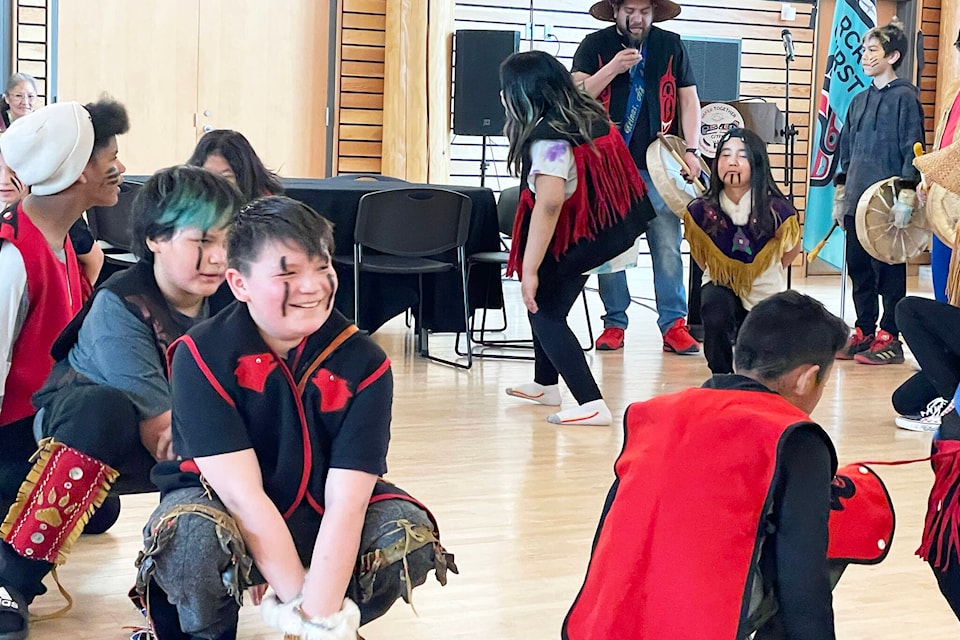Following on the heels of the First Nation governments of Selkirk, Kwanlin Dün, and the Teslin Tlingit Council, the Carcross/Tagish First Nation (C/TFN) celebrated the launch of their community safety officer program, with a twist, on May 26.
Theirs is a variation on a theme — customized for C/TFN citizens by dropping the safety “officer” and adding “wellness” to the program title.
Stacey Robinson-Brown, the health and wellness director with the First Nation, launched the initiative with a performance by the Aan Yatx’i Saanni dancers, and introduced their new safety and wellness liaison person, Sarah Jean Graham, to the community. Graham is not a stranger to the area, having grown up on the traditional territory of the C/TFN.
After the dancing and lunch, Graham explained how the program emphasis shifted at family camp: “The first couple days, I wore a more standard type uniform and was referring to myself as an officer. And I could kind of feel a little friction. So, we had some community discussions around that.”
The result of those conversations led to a shift in apparel, role and name of the program.
“So we switched to basic t-shirt, with our logo on it, which was designed by the community and voted on by council, and removed the word officer.”
The program is now referred to as a safety and wellness initiative.
Community-specific research
The project stemmed from two reports — community safety assessment and crime prevention through environmental design — that were conducted by Gina Nagano through her business, House of Wolf and Associates, Inc.
The company website says that western approaches to mitigating the effects of fractured Indigenous communities have been an abject failure. Nagano believes that it is fruitless to pursue economic development before addressing the social and cultural context of a community.
Nagano told the News on May 30 that the community-specific research reports contain “recommendations of how to move the community forward, based on their community research, and what their citizens are saying. We’re recommending several short, mid- and long-term recommendations to foster the pride and ownership of the community.”
Nagano rejects a one-size-fits-all approach. The set of recommendations could be very different for each community. Nagano gave the example that Little Salmon Carmacks First Nation might not need community safety officers or the like, but a report might point to a greater need for on-the-land monitors to protect natural habitats.
Safety officer programs are operational in Pelly, Kwanlin Dün and Teslin. The First Nation of Na-Cho Nyak Dun is developing a similar program to meet their needs and concerns.
House of Wolf received seed money in the form of a $500,000 Arctic Inspiration Prize for Indigenous-led training, certification and mentorship that enables First Nations governments to own, implement and sustain community safety, emergency preparedness, and justice initiatives. They will also organize and host an Indigenous Community Safety Summit Aug. 2-4 at the Kwanlin Dün Cultural Centre.
On March 14, the Yukon government announced phase one of a new community safety planning program which will fund each First Nation up to $200,000 to support local community safety assessments, planning and initiatives. Phase two will explore potential funding for municipalities.
The assessments identify things particular to each community that can be done to make a difference such as improve street lighting in some areas, house numbers, or improved animal care to prevent incidents with loose dogs.
Not about enforcement
Graham sees herself as a liaison between First Nation members and the RCMP, health centre staff and others. She attends wellness checks. After 10 years as a corrections officer, she is well-trained and practiced in de-escalation techniques.
“I know myself, I am extremely calm. I’m extremely patient. I have great de-escalation skills, extensive training and addictions and mental health,” she said.
As a safety and wellness liaison she is able to choose appropriate responses depending on the setting, the people, and her own experience.
“It’s better for me to go there in a t-shirt and jeans and, let’s sit in the sun, have a smoke, like let’s just hang out,” she said, explaining that makes for a situation that prevents harm and can de-escalate stressful situations.
“I’m very excited to hopefully have earlier interventions and better options,” she said.
The community safety assessment for Carcross and Tagish identified signage as a shortfall, so Graham wants to work on numbering all the houses. In Carcross and Tagish, First Nation’s houses and lots were not included in the civic addressing system and do not have house numbers, even if they reside in a single house on a street amongst other numbered houses. This makes it difficult for emergency responders to find their way to First Nation homes in the communities.
Lighting in the Tagish subdivision is also an issue identified in the crime prevention report.
The C/TFN safety and wellness initiative will serve Tagish and Carcross for now.
“We just acquired a brand-new outreach van and we’ve put out a call for volunteers for that. And it’ll be, Naloxone, harm reduction, that kind of stuff, and also getting the community involved,” says Graham.
One more person needs to be hired so that evening and weekends can be covered in both communities. Graham is looking forward to helping train a new colleague.
“I’m really hoping we can get some citizens, some community members to apply.”
“If I can go somewhere and talk someone down and it prevents them from being arrested or being injured — that is what I want to do.”
Contact Lawrie Crawford at lawrie.crawford@yukon-news.com
